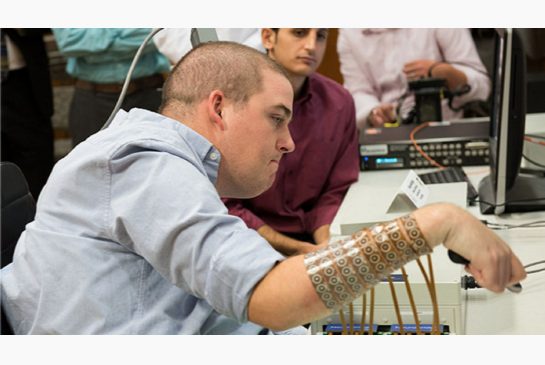-
Tips for becoming a good boxer - November 6, 2020
-
7 expert tips for making your hens night a memorable one - November 6, 2020
-
5 reasons to host your Christmas party on a cruise boat - November 6, 2020
-
What to do when you’re charged with a crime - November 6, 2020
-
Should you get one or multiple dogs? Here’s all you need to know - November 3, 2020
-
A Guide: How to Build Your Very Own Magic Mirror - February 14, 2019
-
Our Top Inspirational Baseball Stars - November 24, 2018
-
Five Tech Tools That Will Help You Turn Your Blog into a Business - November 24, 2018
-
How to Indulge on Vacation without Expanding Your Waist - November 9, 2018
-
5 Strategies for Businesses to Appeal to Today’s Increasingly Mobile-Crazed Customers - November 9, 2018
Brain implant lets paralyzed man regain use of hand
But with the help of a chip implanted in his brain, Burkhart, 24, can control his right arm and wrist – making him the first person with a “reanimated limb”, according to a study published Wednesday in the science journal “Nature”.
Advertisement
Five years ago, a college freshman named Ian Burkhart dived into a wave at a beach off the Outer Banks in North Carolina and, in a freak accident, broke his neck on the sandy floor, permanently losing the feeling in his hands and legs.
Burkhart had a chip implanted in his brain two years ago.
However, with practice he is learning new movements more quickly. He mastered controlling his thoughts and could pull off six hand and wrist movements, including the ability to move individual fingers. The accident left him paralyzed from his elbows down.
The new technology is not a cure for paralysis.
But the field of neural engineering is advancing quickly.
“This is the first time that decoded signals from the brain have been linked to muscle activation in real time in a human”, Chad Bouton, an engineer at the Feinstein Institute and lead author of the paper, said. Previously, people have learned to guide a cursor on a screen with their thoughts, primates have learned to skillfully use a robotic arm using only neural signals and scientists have shown in primates that thoughts can move arm muscles. The study found by using “a nerve bypass”, a person can potentially regain basic motor skills for limbs.
Ohio State UniversityIan Burkhart plays guitar with his thoughts. There, he told doctors that he would be willing to participate in experimental treatments. “Because something I hadn’t moved in about 3 ½ years… now it’s something where I expect it to move”, he said. “But it did mean I had to have brain surgery – surgery that I didn’t need”. From there, the sleeve uses electrical impulses to trigger muscle contractions that allow Burkhart to accomplish the hand movement he’s thinking of.
Rezai implanted a chip the size of an eraser head in the area.
The Ohio State and Battelle teams worked together to figure out the correct sequence of electrodes to stimulate to allow Burkhart to move his fingers and hand functionally.
Mr Burkhart has been attending sessions three times a week to fine-tune the device. The diminutive 4mm by 4mm chip, a Utah array with 96 electrodes, is created to pick up small changes in voltage caused by neurons firing near the electrodes, he explained.
Batelle, however, had spent the better part of a decade developing a technology called Neurobridge.
Perfecting the technology was a years-long process that started even before Burkhart received the implant. His co-authors include a dozen others at Ohio State and Battelle, including Rezai.
It was a shock at first, Burkhart said. An avatar on a computer screen cued him to try different types of movement. “I just kind of think that it’s my obligation to society”, Burkhart said. “A few seconds after the amazement, we said OK, we have much more work to do here”. “We all just look at each other and thought, ‘OK, the work is just starting'”. Now he can open and close his hand, pick up a bottle and pour out its contents, and use a stick to stir the contents of a mug, for example.
Advertisement
For more on spinal cord injury, visit the U.S. National Institute of Neurological Disorders and Stroke. Funding for it runs out later this year. “Right now it’s only in a clinical setting, but it’s something that with enough people working on and enough attention can be something I can use outside of the hospital, at my home, outside of the home, and really improve my quality of life”. “With the movements I can do today, I would take the system home in a heartbeat if they offered it”. “If someone else had an opportunity to do it in some other part of the world, I would hope that they would commit their time so that everyone can benefit from it in the future”, he says. I just made my interest known, and once the researchers got to a point where they were looking for a test subject, they contacted me.





























